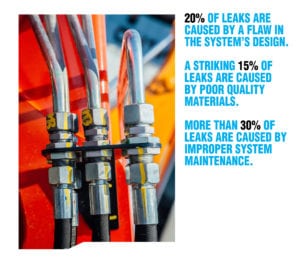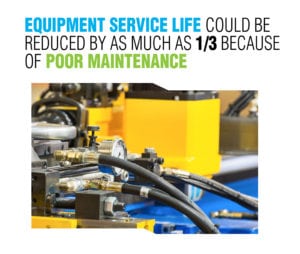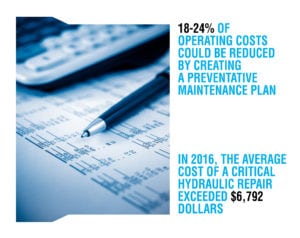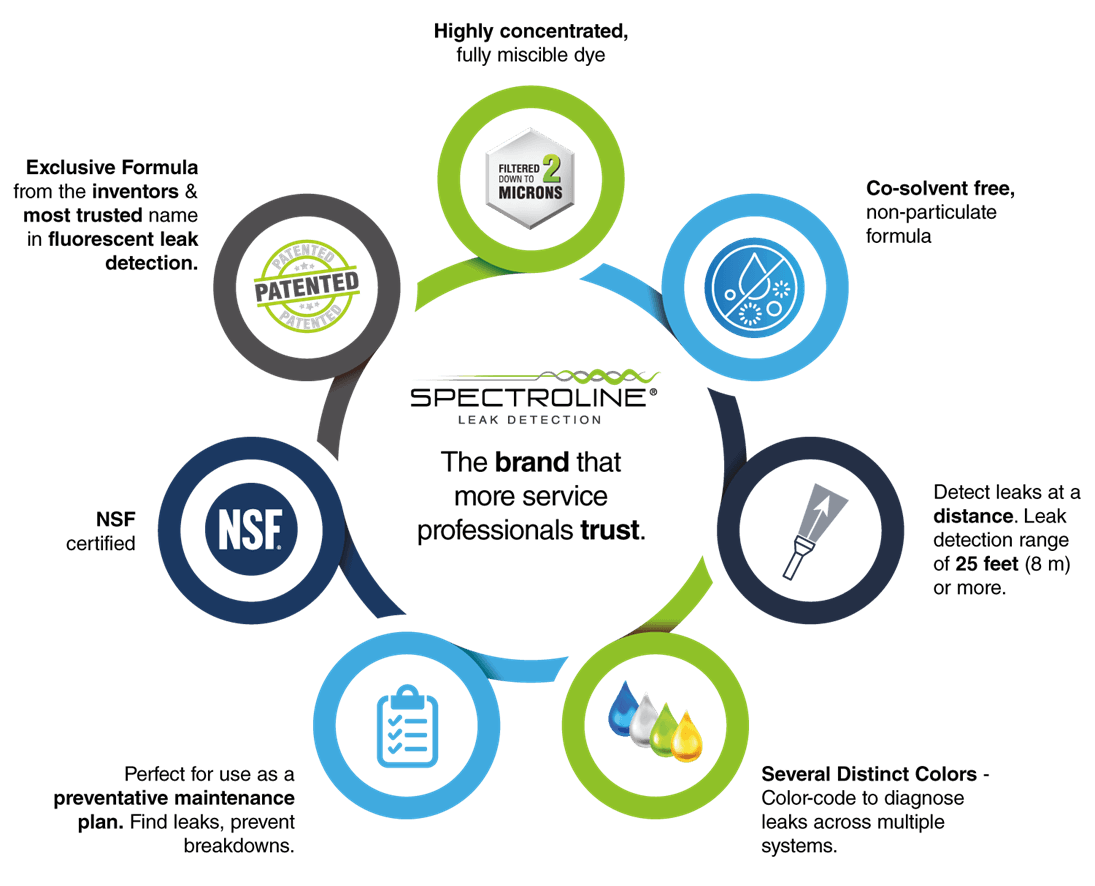Hydraulic Leaks Steal Time and Money
What’s the real cost of leaking hydraulic fluid? The cost of lost operational fluid can rise into tens of thousands of dollars. Fluid-based systems quickly breakdown, overheat, and fail when there isn’t enough vital, operational fluid. Think about it. When your equipment is stuck in the repair shop, it’s costing you thousands in lost operating revenue. That net revenue includes wages, permits, repair costs, lost working hours, reduced equipment service life – everything.
Spectroline developed its own fluid leak calculator to help you determine how much money is being lost. The simple interface helps users find the exact cost of leaks. Our data has been compiled from leading industry reports and our own in-house data. Some of the variables include the number of leak sites, leakage rate, and fluid viscosity. Remember: Hydraulic leaks are a symptom of a larger problem. The condition of your equipment reflects maintenance quality.
Annual Leak Cost CalculatorQuick facts about leaking hydraulic fluid:
- Industrial equipment uses four times the amount of fluid necessary for their intended use. If a leak takes too long to find, it is common practice for operators to only replace the lost fluid and not fix the leak.
- Over 100 million gallons (380 million liters) of hydraulic fluid could be saved every year, in North America alone, if leakage were eliminated.
- A hydraulic fluid leak of one drop per second translates into 420 U.S. gallons (1,600 L) lost per year. At $5 per gallon, the cost of this leakage would be approximately $2,100 per year.
Even a small leak can cause severe damage to equipment. Highly pressurized hydraulic systems quickly break down if something’s wrong.

Let’s talk about the expenses associated with lost operating fluid and what can be done to maintain your hydraulic system.
The Hidden Cost of Leaking Hydraulic Fluid
Going back over 30 years, industry researchers found that 10% of the equipment drives 90% of overall costs. This is primarily due to equipment downtime. There has been a push in recent years for asset managers to have the ability to evaluate equipment in real-time. A centralized monitoring network (comprised of system pressure sensors) have greatly helped asset managers. But the industry, overall, hasn’t implemented these computerized programs universally – primarily because of the upfront cost.
Ultraviolet leak detection is an economical, effective, and easy to add. An asset manager can have his/her crew scan equipment periodically to quickly find leaking hydraulic fluid. In 2015, our clients reported to have a 23% reduction in new persistent leaks within four months.
Over time, it can be difficult to calculate the exact costs of replacing lost operating fluid. In the day-to-day schedule, technicians think very little of lost fluid. When the fluid level is a little low, you add fluid, right? But what you’re not accounting for is the cost of replacing fluid over the service life of equipment. If your team works with a lot of equipment, you likely aren’t accounting for the cost of leaks across all of your inventory. You are simply fixing the day-to-day issues at hand and not considering the larger liabilities associated with reactive maintenance.
Common Causes of Leaks
One of the most common causes of leaks are improperly installed parts and fittings. More than 60% of leaks are caused human error or a flaw in production. Make sure connections and fittings are secure and correctly seated to avoid these mistakes.

Common cause of leaks can be easily avoided. Here are a few starting points to lay the foundation of your maintenance plan:
- Regularly check and inspect your system’s hydraulic pressure.
- Make sure fluid levels are at the manufacturer’s recommended setting.
- Develop a preventative maintenance plan to regularly inspect and record the operating status of your hydraulic equipment.
Preventative Maintenance
Preventative maintenance is essential. Implementing a clear set of maintenance objectives is one the of the keys to ensuring your system is running properly and reduces costly visits to the repair shop.
Constantly replacing lost fluid increases the chance of contamination. Particulate and water contamination can affect the chemical properties of hydraulic fluid. The alteration of these properties – which are critical to the longevity of your hydraulic equipment – will make your equipment run less efficiently.
Maintaining a sealed hydraulic system is paramount to the safe operation and continued longevity of your equipment. Contaminants entering your hydraulic fluid – or hydraulic fluid escaping your system – degrades the system and can lead to operational failure.

Because all parts within a hydraulic system are interdependent, one failing part can upend overall performance. Hydraulic systems are comprised of a reservoir, a pump, valves, hydraulic fluid, motors, hoses, filters, and cylinders. The delicate balancing act between these parts is what allows hydraulic equipment to perform heavy-duty tasks such as excavating and demolition.
In 2017, scheduled preventative maintenance was shown to reduce overall operating expenses by as much as 27% (with perfect execution). The adoption of a PM plan has been shown to reduce operating expenses significantly for equipment that cannot be easily integrated into a centralized, electronic monitoring system.
To learn more about preventative maintenance, please visit: https://spectroline.com/creating-a-preventative-maintenance-plan-for-hydraulic-systems/
Using the appropriate leak detection tools will help preserve the quality of your equipment and extend service life. You can prevent premature wear-and-tear and stop downtime. The Spectroline® ultraviolet fluorescent leak detection method finds leaks within minutes – safely and noninvasively.
The Ultraviolet Leak Detection Method
In a 2018 survey, 87% of respondents said they detected hydraulic leaks faster by utilizing ultraviolet fluorescent dyes (over other leak detection methods). Respondents also reported they were able to reduce the time spent trying to find and repair leaks by one-half.
The Spectroline® method of ultraviolet leak detection is simple, noninvasive, and doesn’t void equipment warranties. This is how it works: Spectroline® ultraviolet dye enters the hydraulic system and circulates around – permeating throughout the entire system. If there’s a leak, the dye exits with the host hydraulic fluid. When the system is scanned with an ultraviolet light leak detection flashlight, the fluorescent dye reacts and glows brilliantly – exposing the exact location of all leaks. Spectroline® has gone to great lengths to develop, test, and meet all the latest industry standards for safety and performance. Spectroline® dyes can remain safely within the hydraulic system and are the perfect diagnostic tool to be used as a part of a preventative maintenance plan. These dyes are trusted by industry leaders and are OEM-approved by many of the world’s leading manufacturers of hydraulic equipment – including Caterpillar®, General Electric®, and John Deere® to name just a few.

Gary Wachter of Rosenboom® said, As a manufacturer of hydraulic cylinders, the integrity of our welding process is critical. We test 100% of our products and have found that it is much easier to identify leaks that may exist in welded joints by using Spectroline OIL-GLO® dyes and inspection lamps. We have been using these products for years and have been very happy with their performance.”
Continued Success
Ultraviolet leak detection, combined with an executable preventative maintenance plan, saved hydraulic equipment operators thousands of dollars per unit (when leaking operational fluid was determined to be the cause of equipment failure). The total investment of implementing a preventative maintenance plan cost companies less than 1% of their total operating budget.
After polling our clients, we’ve determined our product saved our customers an average of $800 dollars per year in lost hydraulic fluid alone (for medium-to-large sized hydraulic equipment). With the average cost of replacing damaged critical parts exceeding $6,792 dollars (depending on the component being serviced), our customers saved at least 15% on production and operating costs throughout the course of a year.
OIL-GLO Ultra Complete
The Spectroline OIL-GLO ULTRA Complete is a violet light fluorescent leak detection kit that pinpoints leaks in all oil-based fluid systems, such as hydraulic systems, compressors, engines, gearboxes, and fuel systems. To use the kit, add OIL-GLO ULTRA fluorescent leak detection oil-dye to the suspect system and scan leak areas with the violet light LED leak detection flashlight included in the kit. The fluorescent dye works in enclosed systems where fluids are used for lubrication, hydraulics, cooling control, or hydrostatic pressure testing. It is a precision-engineered formula that can remain safely within the system, and be used for future leak detection inspections.
Detect Hydraulic Leaks Early
Detecting hydraulic leaks early on saves money. A hydraulic fluid leak of one drop per second translates into 420 U.S. gallons lost per year. At $5 per gallon, the cost of this leakage would be approximately $2,100 per year.


 Leak detection is essential to maintaining a smooth-running fluid system. Low system fluids – such as oil or hydraulic fluid – can affect the equipment’s operation and increase wear-and-tear of internal parts. This leak detection kit prevents expensive equipment breakdowns, reduces labor costs due to downtime, and helps to stop environmental pollution. It has been estimated over 100 million gallons of hydraulic fluid could be saved every year, in North America alone, if leakage were eliminated.
Leak detection is essential to maintaining a smooth-running fluid system. Low system fluids – such as oil or hydraulic fluid – can affect the equipment’s operation and increase wear-and-tear of internal parts. This leak detection kit prevents expensive equipment breakdowns, reduces labor costs due to downtime, and helps to stop environmental pollution. It has been estimated over 100 million gallons of hydraulic fluid could be saved every year, in North America alone, if leakage were eliminated.






